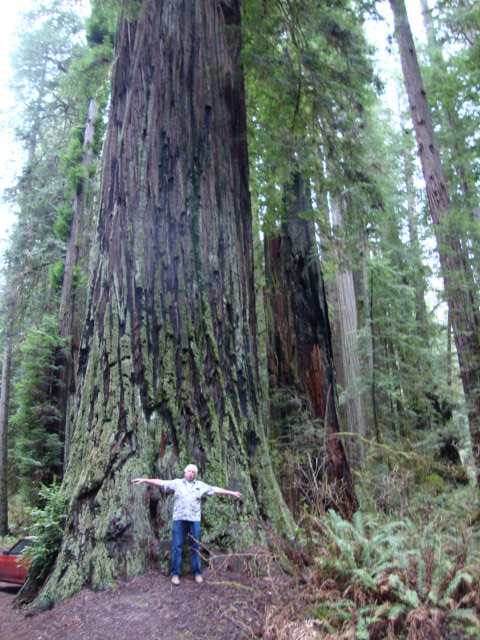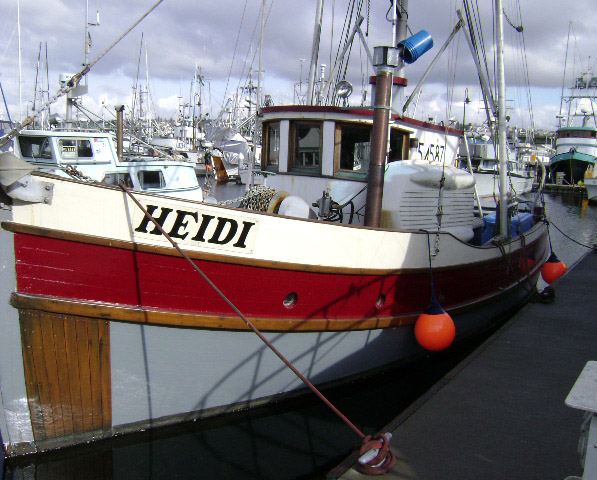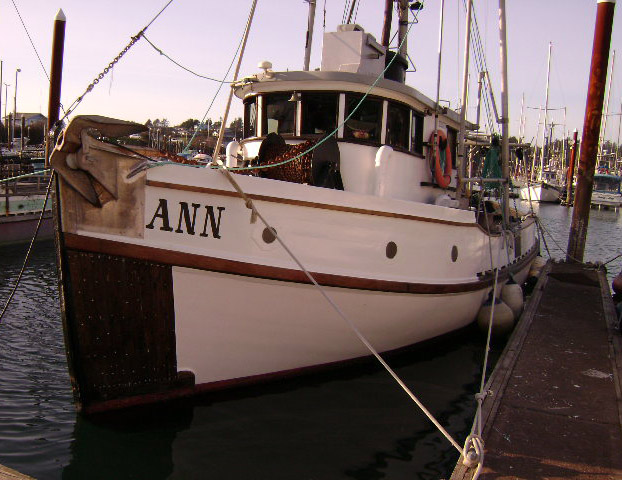A few thoughts about my Northwest….
Occasionally I get an overwhelming urge to again see some of the old time northwest things I was raised around and which are so rapidly disappearing, so get in an old Dodge pickup truck I own and drive over to the coast. For instance; the gypo mill and its sawdust burner. How many of our area’s emigres from other states know what it’s like to drive a rainy windy northwest night along a twisty narrow road on the shores of a Pacific coastal river and to suddenly come upon a 50′ tall glowing red sheet metal cone, burning sawdust from a little mill.
Environmental concerns closed the burners and the scrapers hauled most of them away just 30 years ago yet I know where several still stand, rusting and idle, but still with us. Pilings in a river can make me pause and imagine what activities took place there as recently as when my father was my age. When I was a boy the coastal rivers were still used by the loggers to store and transport the great fir, cedar, and hemlock logs, torn from forests so thick and huge that nobody could possibly dream that in just 25 years saving the remaining few would actually be an issue.
 |
 |
|
This Redwood stand is off Hwy 101 on the Oregon California border. Saint Reagan, when he was governor of California, almost was able to get away with having all of them logged off, but enough people raised hell that a semi decent stand was saved. The highway over the mountain from I-5 snakes between these trees and in places, the trees have been notched to allow big trucks and trailers to make the corners! It’s a great drive, but not for the faint of heart! The arm spread of that goofy looking guy in the photo is 6′. Off on a side road there’s a Redwood with a one lane road cut through the middle of it! |
Old abandoned railroad bridges still lean across a few northwest streams and rivers although their metal tracks were pulled up and sold for scrap and the little steam engines that ran on them stuck away to rust in small town parks long ago. But as recently as 1968 the railroad did run up the Washington coast as far as Moclips and when my wife’s grandmother was young she and her friends would ride the excursion train up from Portland and scoop crabs by the bag full off the beach.
|
|
 A bit more modest home, across the street! |
But what I most miss is the time so shortly passed when the coastal towns were all alive and thriving, not just tourist destinations. While some populous politicians bemoan the fate of the family farm and federal money provides low interest loans and outright grants to farmers, the family owned fishing boat, the small independent canneries, the little boat building and repair firms, the gypo logger, have about all gone the way of the Dodo bird. As recently as the 1980s, Westport and Winchester Bay, Astoria, Newport, Florence, Bandon, and all the other little towns clear down to Santa Barbara were brim full of stout little family owned vessels, tow boats and crabbing boats and draggers and best of all, the trollers.
The trollers were the aristocrats of the fleet. Trollers didn’t trap or snare or drag huge nets across the bottom. Trollers caught fish by outwitting them, fishing for them. Beautiful to look at because their hull lines were created to be sea kindly rather than just working platforms, they ranged the entire coast towing baited lines and catching salmon which is why they were called “trollers.” Even today, “troll caught” is the best salmon because it isn’t marked up from nets nor scooped out of fish farm tanks. They had brave names like “Scout” and “Dauntless” and “Resolute” and Defiant”. Some were named for wives or daughters like “Mary H. or “Patty Ann” or even named for BOTH wife and daughter like the “Helen and Missy.” There was the “Mike” and the “North” and the “Beaver” and a whole host of others from the brave to the sentimental to the silly.
The trollers are slowly disappearing. Oh, there’s still a small active fleet in Alaska, but down here the season is so short that most years a troller can’t earn a living unless he does other fisheries or trades too, so few are still seriously working. A few retired ones can be seen, slowly deteriorating, tied to an old float in some out of the way place. But some are still active, owned by tough and skilled men who refuse to give up and still fish the few days per year the state allows them. And a very few are lovingly maintained and fished by folks with disposable cash, Northwest bred, who love the life and for several weeks out of the year “go fishin” not needing nor caring if they make any money at it.
|
This beautifully kept up troller has been owned by the same man for many years. Some years she isn’t fished, but she’s always kept looking good! |
ANN is owned by a successful Oregon fisherman who usually works big boats. He keeps her in yacht condition and says if fishing ever ends, he’ll still keep her as a yacht. |
But it isn’t like back when I was a boy and a young man could get a commercial license down at the fish and game office, fix up or build a small boat into a troller, and if his luck was good after several years he’d be able to buy a real one. My attempts were in a 21 foot dory with hand powered “gurdies” to manage the lines. I’ve never worked so hard for so little money in my life, which is why I didn’t stick with it. But that’s just paying the dues, and plenty of men DID stick with it, learned how to do it, and supported their families at it. Like the family farm, the family fishing boat was often passed on to a son, a daughter and son-in-law, or sometimes just the daughter, and they too earned their living with it.
The trollers symbolize the northwest to me, and it’s maddening that what killed them wasn’t the inevitable forces of “progress” or “technology” or the very depletion of the resource, those carved in stone things that spelled the doom of the old narrow highways with their covered bridges, the steam trains, the gypo logging. The trollers and the whole way of life they represented were done in by paper decree, by bureaucrats and fisheries managers who didn’t care about anything except managing the “resource,” as the salmon are called today, and who’s business college backgrounds made them unable to see the whole economic and esthetic picture the salmon were the hub of.
By the early 70’s the poor salmon were in trouble. Corporate logging was leveling entire mountains and valleys of their forests leaving a landscape that would rival anything an atomic bomb could do, destroying hundreds of streams where the salmon once spawned. Other rivers were damned up or diverted to irrigation canals, blocking the salmon from their spawning grounds. Off our shores Asian and east European owned fishing factories were spreading their “curtains of death;” nets as long as 30 miles, catching and killing everything that came across them, birds beyond counting, and of course entire schools of salmon.
From a management point of view, a troller is to damned independent. You never know where one will show up and how many salmon he’ll catch. In fact, the “highliner” boats, those that caught the most, often started the season down off San Luis or Monterey, following the fish clear up into Washington.
The first thing the managers did was put in “Limited Entry.” They stopped issuing new licenses. Suddenly a young guy couldn’t fix up a boat and “go fishin.” He had to first buy a license from somebody retiring. The license prices soared, and while today a Washington troll license is practically valueless, in Alaska it can exceed $100,000. Limited entry about shut out new fishermen because you have to buy somebody else’s licensee to fish. It didn’t help the fish because it kept out new people, usually young people, who didn’t know what they were doing so didn’t pose much threat to the fish, but now couldn’t pursue what had been a traditional northwest thing like working in the woods or at a mill. It did nothing at all for the salmon because it didn’t impose any catch limits nor did it effect all the other pressures on the fish. All it did was block people without the money to buy a decent boat and gear and who usually didn’t even know HOW to fish from being able to try it! So next, Washington state decided to buy up all the trollers. Every guy with a rotten boat or who couldn’t catch fish signed up for this program and the state dealt out millions of dollars to buy them out, then auctioned them off for pennies on the dollar with the condition being that once the boat went through the “buy back” program, it couldn’t ever fish again in Washington. Well, Indians bought them since they don’t feel they live in Washington or the US, until it comes time to collect benefits of course. Californians and Oregonians and Alaskans bought them too, and immediately put them back into service in their states. The upshot of it all again had little effect on the salmon, NO effect on the highliners (what a top producing fisherman is called), and still didn’t address the main problems; the environmental destruction and factory fishing ships. It just made one more obstacle for a young guy starting out. Now there were hardly any low end boats to buy so if a guy wanted to be a troller he had to have even more money, and if you have much money you weren’t likely to want to go through all the dues to become a fisherman.
The death of the trollers and with them the real decline of the coastal communities finally came in the early 1980’s when the regulators came up with “closures.” This was the result of several big things. A federal judge named Boldt had decreed that the Indian treaties allowed Indians one half of the harvestable salmon. It came out several years after his death that he was suffering from Alzheimer’s disease when he made this decision, but his ruling stands today. Odd how Indian treaty rights never seem to effect things like downtown Seattle real estate or Weyerhaeuser corporate holdings, but of course little farmers, loggers, or fishing boat owners have neither the money or influence required to protect themselves from the Barons of Capital or Law. And finally, President Reagan’s Secretary of the Interior James Watt announced soon after his appointment that he believed the Second Coming is almost upon us and he knew that Jesus would want to see we had used the Earth’s resources.
This wasn’t the best climate for creative thinking to take place and the way fisheries people went about balancing the declining salmon with the Indians and Jesus was to target specific salmon fisheries and give them certain days to fish specific places. This was an attempt to closely regulate the number of fish caught so they could be divided up among the Indians, the sport fishermen, and the commercial boats.
The reason a troller is damned hard to regulate is because you never know where the guy will show up, which school of fish he’s found, or actually worse, whether or not he’ll catch anything. So the managers wrote them off. One seine boat or gillnetter can be stationed where a school is known to run and can scoop up a predetermined number of fish. A pack of them can close off a river or inlet for 6.2 hours or 3.7 hours or whatever the time frame happens to be that day, and “X” number of salmon will be caught. So today, rather than a great number of small inefficient boats catching the fish, we have a small number of very efficient boats catching the fish.
So what, you’re probably thinking. I suppose I sound like any other aging coot remembering only the good things about years gone by but I miss my old northwest where so much interesting stuff was happening. Tough men and stout little boats like Jack Conway and “Adios,” one of the most beautiful trollers in the fleet, a boat so seaworthy no Pacific storm seemed able to hurt her. “Adios” once surfed a whole quarter mile on her side while riding out an early spring gale, scaring the crap out of Jack while doing it, regaining her feet with a shrug and daring the sea to try something else. Incredible boats like her were suddenly forced to idle away at the dock. When “Adios” and all the others couldn’t fish enough to support themselves whole families saw the end of their livelihood and moved away. When the fishing boats not working the boatyards and chandleries that took care of them closed down and their people moved away. Finally the little canneries, unable to get fish, closed down, and when the cannery closes there goes the town. The cannery was always the place where ANYBODY could get a job; dirty, messy, cold, and often hazardous though it may often be, it was still a job, and many of us from the coastal areas found ourselves working the cannery more than once.
 |
Sadly neglected, then finally abandoned at the dock in Florence Oregon, on her way to a date with the land fill. What a waste…. |
Today (as the November 1995 issue of National Geographic pointed out), we have a few big boats based for the most part in cities, and a whole lifestyle that I loved is gone. It didn’t have to be that way either. Denmark was faced with the same sort of problems. They didn’t have Indian fishing treaties, but they do have neighboring countries which seems to be the same thing. But there, they used the idea of a boat catch quota. Their coastal towns are alive with swarms of small timers and all the inter-related businesses, and fishermen are limited to the number of fish they can catch. Nobody gets rich, but many earn livings. Rather than regulate for corporate interests, they decided to protect the way of life and their small coast town economies.
So as I drive the Washington and once a year often down the Oregon coast too, in my mind I see a chandlery where the kite shop over there sits. The weathered pilings in the bay again have huge rafts of logs tied to them and the old abandoned gypo mill’s rusty machinery and leaning sawdust burner are humming away. The plastic sports fishing boats are gone and I see the harbor brim full of trollers and the bayside motel with heated pool is a cannery. That health food store doesn’t exist at all and the kids playing video games in the arcade are out working with their dads and moms on the land or water. That’s how it was not so many years ago and that’s how it will stay for me even if I must imagine it.
|
This was the cannery in Brookings, Oregon. I don’t know when it was built, but by the 1990s it was shut down and in early 2000 it was torn down. |
An old tug abandoned in the river by Gold Beach. She’s been here for years, almost like she’s refusing to die. |





